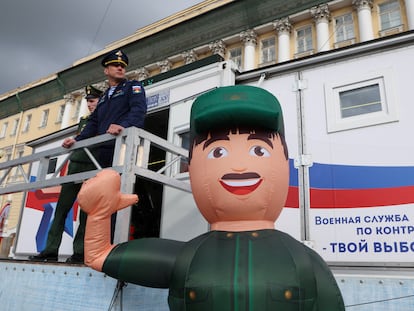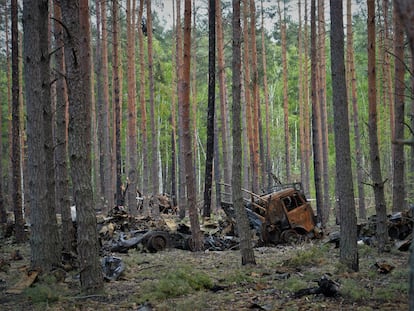Resistance on rails: How Ukraine’s biggest employer is keeping the country moving
A ride with trains chief Oleksandr Kamishin reveals the fight to transport evacuees, aid, returnees and grain exports while under constant Russian attack

Ukraine’s national railway company, Ukrzaliznitsya, the country’s largest employer, is headed by a 37-year-old man who you might easily mistake for a young backpacker. Oleksandr Kamishin’s role is critical in Ukraine’s resistance to Russian aggression. Some 130 of Ukrzaliznitsya’s 231,000 workers have died in the conflict and three have been taken prisoner by Russia. EL PAÍS accompanied Kamishin for two days, traveling to the city of Lviv with the 37-year-old aboard a two-car convoy.
Since the Russian army invaded on February 24, the trains have not stopped running, despite attacks on the railway infrastructure. The most serious so far was the bombing of Kramatorsk station in the east of the country which occurred on April 8. Among the citizens waiting for a train, at least 57 people died.
The railways are Ukraine’s link to the international community, providing access to Kyiv for political leaders, diplomats and businessmen. Trains are also essential for transporting refugees in and out of the country, as well as humanitarian aid, troops, weapons and other goods.
“The history of this war is the history of the trains,” Kamishin tells EL PAÍS. His main problem right now, along with the safety of staff and passengers, is the threat of Russian bombs. Since the war began the director has spent most of his time aboard trains and in stations across Ukraine.
Watched over by two bodyguards, Kamishin’s daily schedule is secret and he is separated from his family. He carries a gun and his little son’s stuffed owl toy with him everywhere.
Since Russia’s attack, says the railway boss, “we [Ukrainians] have shown that we are more European than anyone else,” he says; a reference to his government’s demand for full integration into the European Union.
Along the way, the train also stops at two of the six electrical substations attacked by Russian missiles on May 3 so that Kamishin can inspect these critical sites for the infrastructure of Ukraine’s resistance. He offers encouragement to employees and reviews repairs amid burnt-out transformers and new railway sleepers. Later there will be time to replace broken windows and repair other less urgent damage.
Not all the Ukrzaliznitsya workers killed since the beginning of the invasion lost their lives while working; some were at home. Of those taken prisoner by Russia, only one has been released. “We need them,” he says of the missing workers.
Kamishin, in sneakers, cargo pants, and short-sleeved shirt, says: “I don’t know if I’ll ever wear a tie again.” On his left wrist, he wears bracelets in the national colors of yellow and blue and sports a ponytail tied up with a rubber band on his head which is shaved on both sides. He takes video calls while he walks the platforms, making momentous decisions for Ukraine via the screen of his smartphone. He hardly allows himself the distraction of watching an edited video of Bono, lead singer of the band U2, performing in a Kyiv metro station.
During this war, more than four million people have been evacuated via the Ukraine train network, which comprises 107 stations and 22,000 kilometers of railway. Twenty percent of the network is controlled by the Russians.
Of the evacuees from Ukraine, 600,000 were transferred abroad. To streamline the operation, train services were provided free of charge. Three months later, many of those who fled have returned. Right now, there are more people coming back than leaving.
Indeed, ordinary Ukrainians are at the center of Kamishin’s concerns, as is evident at the railway station at Lviv, the largest city in the west of the country. Here, Kamishin monitors the arrival of residents fleeing the fighting in the east as they queue up to get their $80 in state aid, $100 if they have a disability or dependent minors.
At the World Economic Forum meeting in Davos, Ukrainian President Volodymir Zelensky himself noted the efforts of Kamishin, saying that the railways are the key to getting millions of tons of grain out of Ukraine now that most of the Black Sea and Sea of Azov ports have been blocked by the conflict.
To be sure, up until the Russian invasion, Ukraine exported six million tons of grain every month. By March this year, only 200,000 tons were leaving the country.
Okelsandr Pertsovskii, who manages passenger flow for the railway company, says that only two ports – those of Izmail and Reni, on the waters of the Danube River before it empties into the Black Sea – are still operational, and they are not enough. Half of the corn and a third of the wheat imported by the European Union come from Ukraine, worth some €13 billion to the country.
The EU and Polish flags mark the impending border with Ukraine as the train comes to a screeching stop and two armed soldiers watch from an iron footbridge over the road. Oleksandr Kamishin walks along the tracks, speaking with staff and expert observers. He confirms that 82,000 tons of grain currently wait in border warehouses. Getting the grain to the border with Poland has not been a problem, he says, but getting it to Europe is. He is calling for more cooperation from the other side.
When a Russian attack on the railway network begins, says Oleksandr Pertsovskii, company managers receive images on their phones and make decisions about repairing the damage as fast as possible and with as much care for the employees as possible.
Occupied by the Nazis in World War 2, Lviv is no stranger to the importance of rail networks, as Pertsovskii points out. “My grandfather, who I never met, was in Lviv defending the border against the German Nazis,” he says. “Our family was evacuated on a freight train to Turkmenistan. My grandmother used to tell us stories about the train when I was a child, about how German planes bombed them while they were in the wagons.”
Eight decades later, Oleksandr Kamishin took up the role of railway chief in August 2021, having worked in the private sector as well as the Ministry of Infrastructure.
After lunch, Kamishin opens the photo gallery on his phone and recounts his life over the past months. “It was 11pm on February 23,” he says, pointing to a photo of his wife and children at home. “We didn’t know the war was going to start.”
He scrolls through to a photograph of his son making bracelets in the national colors that they later sell in order to help the Ukrainian army. While touching one of those same bracelets that he wears, Kamishin says, “My family is safe.” With this knowledge, he adds, “I can endure living like this … until death if necessary.”
As the train stops once more, Kamishin says goodbye and alights with his team and bodyguards. His hand on the pistol bulging in the zippered pocket of his right leg, the Ukrainian railway leader says: “We are Europeans in Europe fighting against these barbarians and we will never stop.”
We fight to the end, he says. “There is only one option, victory.”
Tu suscripción se está usando en otro dispositivo
¿Quieres añadir otro usuario a tu suscripción?
Si continúas leyendo en este dispositivo, no se podrá leer en el otro.
FlechaTu suscripción se está usando en otro dispositivo y solo puedes acceder a EL PAÍS desde un dispositivo a la vez.
Si quieres compartir tu cuenta, cambia tu suscripción a la modalidad Premium, así podrás añadir otro usuario. Cada uno accederá con su propia cuenta de email, lo que os permitirá personalizar vuestra experiencia en EL PAÍS.
¿Tienes una suscripción de empresa? Accede aquí para contratar más cuentas.
En el caso de no saber quién está usando tu cuenta, te recomendamos cambiar tu contraseña aquí.
Si decides continuar compartiendo tu cuenta, este mensaje se mostrará en tu dispositivo y en el de la otra persona que está usando tu cuenta de forma indefinida, afectando a tu experiencia de lectura. Puedes consultar aquí los términos y condiciones de la suscripción digital.
More information
Últimas noticias
David Bowie, the galactic thinker who encouraged us to break new ground
John Berger and the loss of rural culture
From police officer to bloodthirsty kidnapper: Terror in Mexico during the years of ‘The Ear Chopper’
Alain Aspect, Nobel laureate in physics: ‘Einstein was so smart that he would have had to recognize quantum entanglement’
Most viewed
- David King, chemist: ‘There are scientists studying how to cool the planet; nobody should stop these experiments from happening’
- Reinhard Genzel, Nobel laureate in physics: ‘One-minute videos will never give you the truth’
- Oona Chaplin: ‘I told James Cameron that I was living in a treehouse and starting a permaculture project with a friend’
- Sinaloa Cartel war is taking its toll on Los Chapitos
- Mexico completes its trade shift with the entry into force of tariffs on China and countries without trade agreements










































